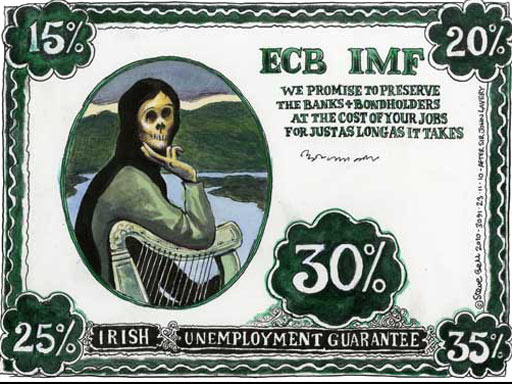Archive for the ‘Robert Ballagh, Artist,Political Activist’ Category
Robert Ballagh’s “The Thirtieth of January”: A Bloody Sunday Painting and the Troubles in the Two Bits of Ireland
In this interview the artist Robert Ballagh discusses the painting “The Thirtieth of January”, depicting Bloody Sunday in Derry in 1972. The conversation provides valuable insights into Ballagh’s personal experiences and artistic process, shedding light on the political and social context of the time.
The interview provides a unique insight into the historical and cultural significance of the painting.
Critical issues related to the Irish government’s response to the conflict, the impact of the Bloody Sunday event, and the broader social and political implications are highlighted. Ballagh’s commentary on the role of the Irish government, the impact on nationalist communities, and the establishment of the Special Criminal Court adds depth to the discussion.
Bloody Sunday Painting – the Thirtieth of January – Robert Ballagh
Thursday, January 20 2022. John Meehan interviews the artist Robert Ballagh in Number Five Arbour Hill.
We are talking about Robert’s painting : The Thirtieth of January, a representation of Bloody Sunday in Derry, January 30 1972.
John Meehan :
Why did you zone in on Derry’s Bloody Sunday , and put so much effort into making this painting? What makes it different from so many other big events during “The Troubles” in the north of Ireland, which lasted for 30 years, from 1968 to 1998?
Robert Ballagh
Well, it’s a long time ago now 50 years, but I have to say that it had an enormous effect on me, and I don’t think I’m alone with that historical experience. I suppose one thing I should say, I was only thinking about this, and I haven’t said anything about this experience to others. I’m a Dubliner. I’ve lived all my life in Dublin. But unlike most Dubliners – it wasn’t by design – I had an extraordinary rich knowledge of the North of Ireland, before the conflict began. Because I was a professional musician in a showband. We used to play at least once or twice a week in the north. So I was in every town village or city in the north that had a ballroom or ballrooms. And so I experienced the reality of life in that society, and became very aware of the sectarian differences, shall we say – the nature of the society, which people didn’t appreciate at all. I tell one very short story to illustrate that. We played fairly regularly in one of the very popular ballrooms in Belfast : Romano’s in Queen Street. We developed quite a following! In the show business vernacular the word groupie was used. These girls used follow us, they came down to Dublin once or twice to hear us. And we were playing one night in Romano’s.

After the dance, they came up and we’re talking to us. They asked “When are you playing again in Belfast?”.
I remember saying “Oh, I think we’re here next week.”
“Oh, really?”
“Yeah – we’re playing in a ballroom called the Astor” which I knew was in Smithfield.
And they said, “Oh, we can’t go there.” And I said, “Why?” – because it was a public ballroom. It wasn’t attached to any organization or anything. It was a public ballroom.
They said, “Oh, no, that’s a taig hall”
And it was the first time I realized, and we realized, that our fan base in Belfast was Protestant.
Written by tomasoflatharta
May 28, 2024 at 8:50 am
Posted in 2018 Referendum to Repeal the 8th Amendment to the Irish Constitution, 26 County State (Ireland), Abortion, Archbishop John Charles McQuaid, Arts and Culture, “A Carnival of Reaction” - James Connolly’s Warning About the Partition of Ireland, Bloody Sunday, Bloody Sunday, Derry, January 30 1972, Britain, British Empire, British State (aka UK), British State Collusion with Loyalist Murder Gangs, British Tory Party, Catholic Church, Child Abuse, Derry, Derry Civil Rights March, October 5 1968, Drew Harris, Garda Commissioner, Drew Harris, Roya; Ulster Constabulary and An Gárda Síochána, Dublin Governments, Feminism, Fourth International, Garda Síochána, Good Friday Agreement 1998, History of Ireland, International Political Analysis, Ireland, Legislation in Ireland to Legalise Abortion, Mass Action, Miami Showband Massacre, 1975, Paul Murphy TD Dublin South-West, Police Forces in Ireland, Referendum in 1998, Deletion of Articles 2 and 3 from the Irish Constitution, Referendums, Religions, Revolutionary History, RISE, Robert Ballagh, Artist,Political Activist, Robert Ballagh’s Painting, January the Thirtieth, RUC/PSNI, Six County State, Special Criminal Court, Ireland, Unionism, Vatiban, War and an Irish Town (Eamonn McCann)
Tagged with Abortion, Archbishop John Charles McQuaid, Belfast, brexit, campaign, capitalist, consequence, constitution, counties, criminal court, criminal courts, eu, europe, Feminism, Fianna Fáil, Fine Gael, general, government, history, Human Rights, Internment, Ireland, irish, Irish Left, irish-identity, irish-politics, jury, north, Northern Ireland, open-borders, partition, people, police, politics, Racism, significant, Sinn Féin, socialist renewal, state
